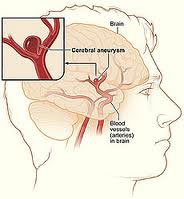Brain aneurysm: so hidden, so deadly
A brain aneurysm is a balloon-like bulge occurring in the artery—the blood vessel that delivers oxygen-rich blood—located in the brain area.
Usually, people are not born with brain aneurysm as it often develops after the age of 40. This deformation usually develops at branching points of an artery where there is a weak or thin spot and where there is a constant pressure from blood flow.
Brain aneurysm often enlarges slowly and becomes weaker as it grows, just as a balloon becomes weaker as it stretches.
Accidentally caught
Brain aneurysm often has no symptom. Most cases are accidentally caught during head imaging tests such as computed tomographic angiography or magnetic resonance angiography.
However, as brain aneurysm enlarges, it can produce headaches or localized pain. If a brain aneurysm gets very large, it may produce pressure on the normal brain tissue or adjacent nerves and could cause difficulty with vision, numbness or weakness of an arm or leg, difficulty with memory or speech, or seizures.
If an individual complains of these symptoms, the doctor would usually order a more reliable test called a diagnostic cerebral angiogram. In this test, the patient lies on an X-ray table as a small tube is inserted through a blood vessel in the leg and guided into each of the blood vessels in the neck that go toward the brain.
Most reliable
A dye is then injected and pictures are taken of all of the blood vessels in the brain. While this test is slightly more invasive and less comfortable, the diagnostic cerebral angiogram is the most reliable way to detect all types and sizes of aneurysms present in the brain area.
Since rupturing is the only thing that could provide a clue of a brain aneurysm’s existence, these imaging tests are now regarded as an important lifesaver.
While experts have many opinions on why brain aneurysm bleeds or when exactly it will bleed, these conditions are often cited as possible causes: high blood pressure often due to heavy lifting or straining; strong emotions like when an individual becomes too upset or angry; and the regular use of blood “thinners” (such as warfarin) as well as some medications and prescription drugs.
Worst headache
The victim will often complain of having the “worst headache of his or her life,” which is then followed by nausea, vomiting, trouble speaking or understanding language, vision problems and then coma.
At this stage, the individual should now be in a hospital as there is up to 40-percent chance of death if the ruptured brain aneurysm is not taken care of surgically.
This is because, once blood enters the brain and the space around it, brain tissues swell or are subjected to increased pressure. Blood can also irritate and cause normal blood vessels to constrict, causing interruption of normal blood flow to the brain tissue.
Treating brain aneurysm— installing a surgical clip around its base, employing drugs to prevent seizures as well as control headaches and blood pressure—centers around the prevention of rebleeding of the ruptured bulge or making sure there is no pressure that could press brain tissues.
Often deadly
Because ruptured brain aneurysms are often deadly—about 25 percent of people die within one day, and another 25 percent die within about three months and of those who survive, about 25 percent will have some sort of permanent disability—experts suggest individuals to be proactive.
If an individual has a higher risk of developing the condition such as regular cigarette use, having a history of brain aneurysms in closely related family members, high blood pressure, arteriosclerosis or hardening of the arteries, or experiencing symptoms related to brain aneurysm, the person is advised to see a doctor and discuss the possibility of having the brain arteries examined via imaging.















